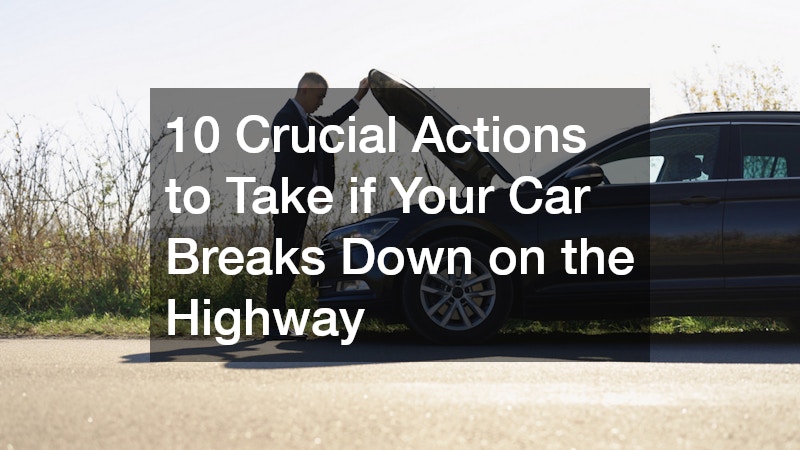Experiencing a vehicle breakdown on the highway can be stressful, even for experienced drivers. One moment, you’re cruising along, and the next, your car decides it’s had enough. But don’t panic! With a calm mindset and a few clear steps, you can handle the situation safely and efficiently. Let’s walk through exactly what you should do.
1. Stay Calm and Assess the Situation
The first and most important thing to do when your car breaks down is to stay calm. It’s easy to let panic set in, especially if you’re on a busy highway or it’s dark outside. But losing your cool won’t make the car start again—and it could actually make the situation more dangerous. Take a few deep breaths, roll your shoulders, and remind yourself that most breakdowns, while inconvenient, are manageable. A calm mindset will help you think clearly and act safely.
Once you’ve taken a moment to settle your nerves, it’s time to assess the situation carefully. The clearer you are about what’s happening, the better your next moves will be. Start by asking yourself some basic questions:
-
Is my car still moving, or has it come to a complete stop? Understanding this will determine whether you can slowly maneuver your vehicle to a safer spot or if you need help immediately.
-
Am I in a dangerous spot? High-speed lanes, sharp curves, or blind hills make even minor breakdowns risky. Identifying your location helps you plan the safest way to protect yourself.
-
Are there any visible signs of trouble? Look for smoke, sparks, unusual noises, or fluid leaks. These clues can tell you whether the issue is something minor or something that could become serious if you continue driving.
Also, take a quick inventory of your surroundings. Are there other vehicles nearby? Is the shoulder wide enough to pull over safely? Are there streetlights or other visibility factors that could affect your safety? Taking note of these details now can save you from making hasty decisions later.
Remember, staying calm and assessing the situation isn’t just about the car—it’s about your safety and the safety of anyone else in the vehicle. Even a small lapse in judgment can lead to a collision or put you in harm’s way. Treat these first moments after a breakdown as your opportunity to set up the safest path forward.
2. Move Your Vehicle to a Safe Spot
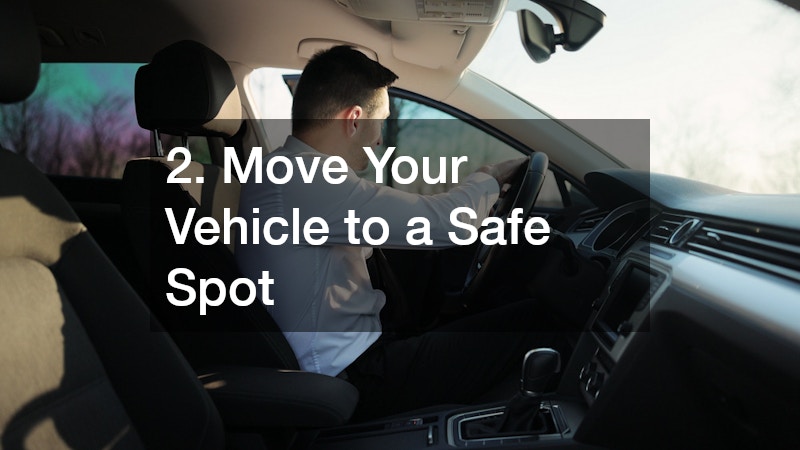
Once you’ve assessed the situation, the next step is to move your car out of traffic, if possible. Even a few feet can make a huge difference in your safety and help prevent accidents. The goal is to create a buffer between your vehicle and fast-moving traffic while you figure out your next steps.
Steering to the Shoulder or Safe Area
Start by steering your vehicle to the shoulder, a breakdown lane, or any safe area away from the flow of cars. If there’s a wide shoulder, pull as far off the road as you can. If you’re on a curve or just over a hill, be extra cautious—stopping there can be extremely dangerous because other drivers may not see you until it’s too late.
When Your Car Won’t Move
Sometimes, despite your best efforts, your car might not move under its own power. Don’t risk pushing it into traffic, as this could put you or others in serious danger. In situations like this, the safest option is to wait for a tow truck or roadside assistance to arrive. Professional help ensures that your car can be moved safely without exposing you to traffic hazards.
Small Movements Matter
Even small movements can make a big difference. Nudging your car just a few feet onto a shoulder or into a safer lane can drastically reduce your risk of being hit. Think of this step as laying the groundwork for everything that comes next—you’ve taken your first big action toward keeping yourself and your passengers safe while dealing with the breakdown.
The goal here is simple: reduce the risk of a collision while you deal with the problem. Even if it means just nudging your car a few feet, it’s worth the effort.
3. Use Hazard Lights and Warning Devices
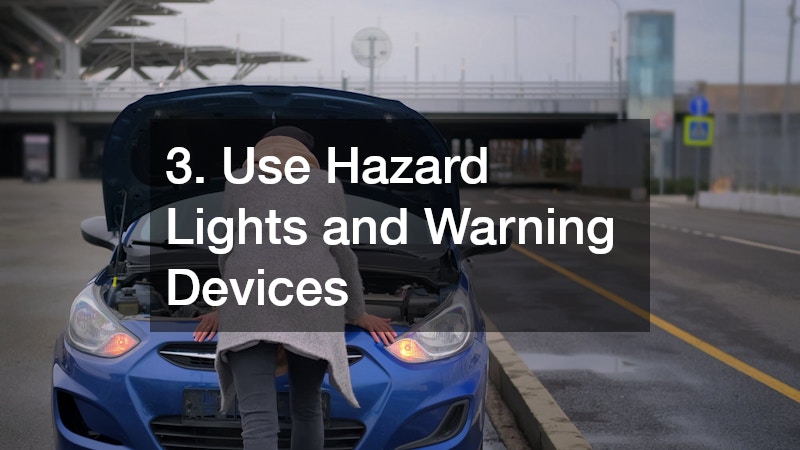
Once your car is safely positioned, it’s time to alert other drivers to your presence. Your hazard lights are your first line of defense—turn them on immediately, even during the day, so approaching vehicles know to slow down and give you space.
Make Yourself Visible
If you have warning devices, now is the time to use them:
-
Place reflective triangles behind your car at intervals to give drivers advanced warning.
-
Use road flares, especially at night or in low-visibility conditions, to increase your visibility.
-
Keep your vehicle lights on, including parking lights, to make it easier for others to see you from a distance.
Making yourself visible is not just about preventing accidents—it also helps the tow driver or emergency personnel locate you quickly once help is on the way.
Why Visibility Matters During a Tow
Even after you’ve called for help, remember that towing personnel will need to safely approach your vehicle. The more visible your car is, the faster and safer they can secure it for transport. Proper use of hazard lights and warning devices protects both you and the professionals assisting you.
These steps help prevent secondary accidents and ensure that you stay safe while waiting for assistance to arrive.
4. Call for Roadside Assistance or a Tow
After securing your vehicle, it’s time to reach out for help. Even if you have some mechanical knowledge, it’s often safer to let professionals handle highway breakdowns—especially on busy roads or in challenging conditions.
Contact Your Roadside Assistance
If you have a roadside assistance service, call them immediately. Provide your exact location, a description of your vehicle, and a brief explanation of the problem. The more details you give, the faster they can send the right help.
Reach Out to Towing Services
If you don’t have a membership, don’t worry—there are plenty of towing services that can assist you. Many of these companies operate around the clock, so you can rely on 24 hour towing companies to get to you quickly, no matter the time of day. When choosing a service, pick a reputable company with good reviews or one recommended by friends or family.
Stay in Communication
Always stay on the phone until help is confirmed. Keep your phone close, follow any instructions from the operator, and let them know if your situation changes. Trying to fix serious mechanical issues on a busy highway can be dangerous, so don’t hesitate to call in the pros—it’s the safest and fastest way to get your car off the road and onto the path to repair.
By contacting reliable local towing services quickly, you minimize risk, reduce stress, and ensure your car gets the help it needs safely and efficiently.
5. Check for Minor Fixes You Can Do Safely
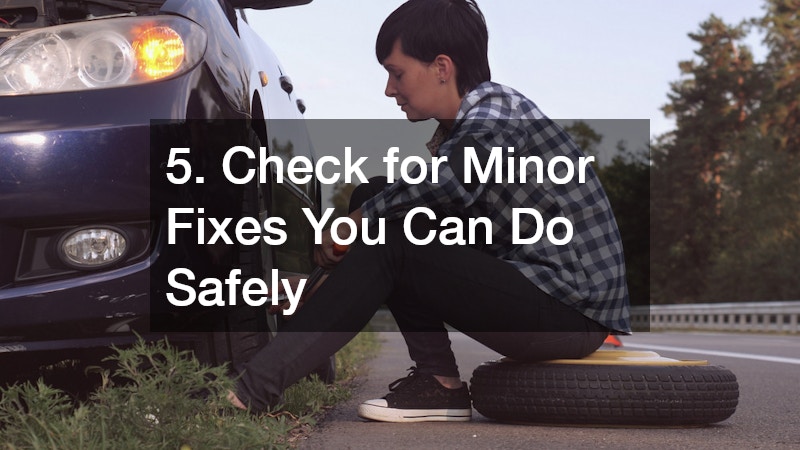
Sometimes, the problem might be minor enough to handle on your own—but only if it’s truly safe to do so. Your first priority is always personal safety, so make sure your car is well off the road and hazard lights are on before attempting any fixes. Even simple issues can become dangerous if you’re on a busy highway or standing too close to traffic.
Common Minor Issues
-
Loose Gas Cap: It might seem small, but a loose or damaged gas cap can cause your car to stall or trigger a check engine light. If you notice this, tighten it securely and see if the warning clears.
-
Flat Tire: If you have a spare tire, jack, and the know-how, you can replace a flat tire safely—but only if you’re on solid, level ground away from moving traffic. Make sure your vehicle is in park and the emergency brake is engaged.
-
Dashboard Warnings: Pay attention to any obvious indicators on your dashboard, such as oil pressure, battery, or engine lights. Some of these issues may have a simple, quick solution, like topping off fluids, while others may require professional attention.
Safety First
Never attempt car repairs in high-speed traffic or without proper safety measures. Avoid leaning under the car, crawling beneath it, or standing in active lanes—even for something that seems quick. If you’re unsure about the problem, or if the repair requires tools or parts you don’t have, it’s always better to wait for professional help.
Remember, minor fixes can save time, but your safety is far more important than trying to solve the problem on your own. Taking a moment to evaluate what’s safe—and what’s not—can prevent a small issue from turning into a bigger, riskier situation.
6. Know When to Wait in Your Car vs. Outside
Deciding whether to stay in your car or step outside can be tricky, and the right choice depends on traffic conditions, weather, and your surroundings. Your safety should always be the top priority, so it’s important to weigh the risks before making a move.
When Staying Inside Is Safer
If you’re on a busy highway, in low visibility conditions like fog or heavy rain, or if traffic is moving fast, it’s generally safer to stay inside your vehicle. Keep your seatbelt fastened and doors locked to protect yourself from any unexpected collisions. Even if your car feels cramped, being inside a stationary vehicle provides a layer of protection from speeding cars.
When It’s Safe to Step Outside
You can step outside only if your car is well off the road and there’s a safe distance between you and passing traffic. Take note of the shoulder width and ensure there’s no immediate danger from vehicles. Keep your emergency flashers on regardless of whether you’re inside or outside the car, so other drivers can see you from a distance.
Being aware of your surroundings—including the behavior of nearby drivers, road curves, and visibility—will help you make the safest decision while waiting for assistance. Always err on the side of caution: if it feels unsafe, stay put until help arrives.
7. Protect Yourself From Passing Traffic
Even when your car is on the shoulder, passing vehicles still pose a threat. Highway traffic moves fast, and drivers may not always notice a stopped car until it’s too late. Protecting yourself is essential, especially if you have passengers.
Simple Safety Steps
-
Stand on the side of your car away from traffic. Avoid positioning yourself between the car and moving vehicles.
-
Keep children and pets inside the vehicle if possible. Their safety is harder to control if they’re outside in a busy traffic environment.
-
Avoid walking along the highway unless absolutely necessary. If you must exit, do so carefully and stay as far from lanes of traffic as possible.
-
Use reflective clothing or bright colors if you need to leave your vehicle, especially at night or during poor weather. This increases your visibility to drivers.
The goal is to minimize exposure to moving cars and ensure that everyone in your vehicle remains out of harm’s way. Even small precautions, like choosing the safest side of the car or keeping passengers inside, can make a huge difference.
8. Keep Emergency Supplies Handy
Being prepared can make a breakdown much less stressful, and a well-stocked emergency kit is your best friend in these situations. Having the right tools and supplies ready ensures you can handle minor issues, stay safe, and even wait comfortably if help is delayed.
Essential Emergency Items
Consider keeping the following in your car at all times:
-
Jumper cables for battery emergencies
-
Flashlight with extra batteries to see and signal at night
-
Reflective triangles or road flares to alert drivers of your presence
-
Basic tools and a first aid kit for minor repairs or injuries
-
Bottled water and non-perishable snacks in case you’re stranded for a while
-
Blankets or warm clothing for cold weather or nighttime waits
Having these supplies ready can make a big difference if you have to wait for an extended period, particularly at night or in bad weather. Even simple items like a flashlight or reflective triangle can significantly increase your safety and comfort while waiting for assistance.
9. Document the Breakdown for Insurance Purposes
After you’ve handled the immediate safety steps, don’t forget to document the incident thoroughly. Keeping detailed records is especially important if your breakdown results in damage, a tow, or any kind of accident. Proper documentation can save you time, money, and headaches later when dealing with insurance or repair services.
What to Record
-
Photos: Take clear pictures of your vehicle from multiple angles, including any visible damage. Don’t forget to capture the surrounding area, road conditions, and any hazards that may have contributed to the incident.
-
Details: Note the exact location, date, and time of the breakdown. Include any unusual circumstances, like poor weather, traffic conditions, or mechanical issues that were evident before or during the breakdown.
-
Receipts: Keep receipts from tow truck services or any emergency assistance you called. This documentation is crucial for insurance claims or reimbursement if your policy covers towing or emergency services.
-
Contacts: Record the names, phone numbers, and other relevant contact information of anyone involved, including witnesses, towing personnel, or roadside assistance operators.
By taking these steps, you create a clear record of the incident that can help protect you financially and legally. Even small details can be invaluable if an insurance claim needs to be filed or if there are questions about the circumstances of the breakdown. A little extra time documenting the situation now can prevent major headaches later.
10. Address Repairs Promptly
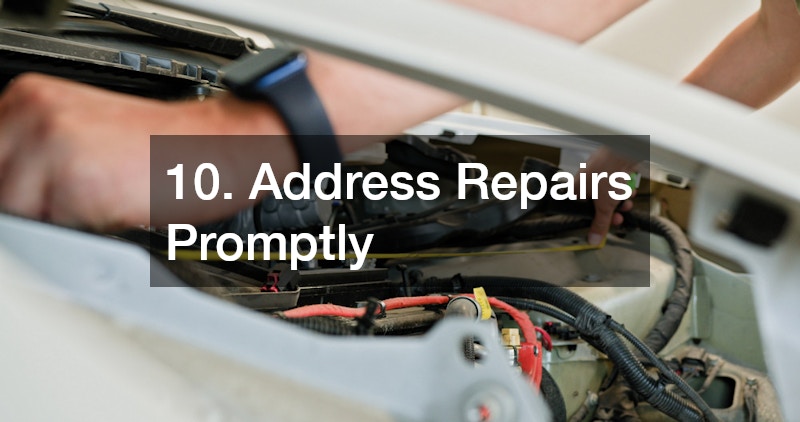
Once your car is safely off the highway and the immediate danger has passed, it’s crucial to tackle any needed repairs without delay. Ignoring minor issues can quickly turn them into bigger, more expensive problems, and it increases the risk of another breakdown or more serious damage.
Get a Professional Inspection
Take your vehicle to a qualified mechanic in your area. Leading auto repair companies offer thorough inspections to identify the root cause of the breakdown, whether it’s a worn belt, fluid leak, or an electrical problem. Ask for a detailed explanation and a clear repair estimate so you know exactly what needs to be fixed and why. Even minor issues that seem manageable on your own can sometimes require professional tools or expertise.
Prioritize Safety-Critical Repairs
Focus on safety-related components first, such as brakes, tires, steering, and lights. Even if your car feels okay after the breakdown, leaving these items unattended can be risky. Small problems like low fluids, loose hoses, or worn belts can escalate quickly if ignored. If your vehicle suffered any impact during the breakdown or while being moved, it may also require collision repairs, which should be handled promptly to ensure the car is safe to drive.
Don’t Delay
Schedule the repairs as soon as possible. Waiting can increase repair costs and put you at risk of another roadside emergency. Handling repairs promptly ensures your car remains reliable, safe, and ready for your next trip. Addressing issues quickly—whether routine maintenance or collision damage—keeps your vehicle in top shape and helps prevent bigger headaches down the road.
Prevent Future Breakdowns: Tips for Maintaining Your Car
The best way to handle breakdowns is to prevent them from happening in the first place. Regular maintenance keeps your car running smoothly and reduces the likelihood of roadside emergencies, saving you both time and money.
Stick to a Maintenance Schedule
Follow your manufacturer’s recommended service intervals for oil changes, fluid checks, and tire rotations. Staying on top of routine maintenance keeps all systems operating efficiently and can prevent small issues from becoming major problems. Regular visits to transmission shops for fluid checks and inspections, for example, can help prevent serious drivetrain problems before they happen.
Inspect Key Components Regularly
-
Tires: Check tire pressure and tread depth frequently. Uneven wear or low pressure can lead to blowouts or loss of control. Getting car alignments done periodically ensures even tire wear and smoother handling.
-
Brakes: Listen for unusual noises and monitor brake responsiveness. Worn brakes are a common cause of roadside emergencies.
-
Fluids: Keep an eye on engine oil, coolant, transmission fluid, and brake fluid levels. Low fluids can cause overheating or mechanical failure. Regular checks and top-ups help avoid breakdowns and expensive repairs.
Keep a Maintenance Log
Tracking your car’s service history helps you stay organized and ensures nothing is overlooked. Note oil changes, tire rotations, repairs, and inspections. This log is especially helpful when scheduling future maintenance and can save you from unexpected breakdowns.
By staying proactive with repairs and maintenance, you’ll drive with greater confidence and greatly reduce the chance of ending up stranded on the side of the road.
Final Thoughts
Vehicle breakdowns on the highway are stressful, but they don’t have to be dangerous if you follow the right steps. Stay calm, move your car to a safe spot, alert other drivers, call for assistance, and protect yourself while waiting. With preparation, a clear head, and proper safety measures, you can handle a breakdown efficiently and minimize risk.
Remember, prevention is just as important as response. Keep your car well-maintained, stock emergency supplies, and always have a plan for unexpected situations. A breakdown may be inconvenient, but it doesn’t have to turn into a disaster.

